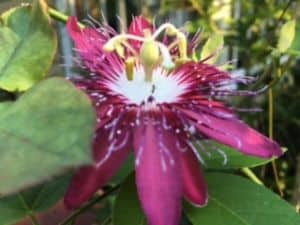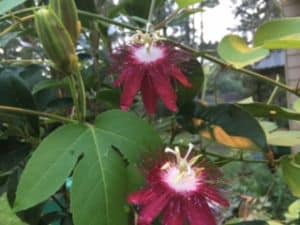
Passionflower
Passiflora – commonly known as Maypop, Passionvine or Passionflower, is a vine with unusual and exotic looking blooms. The flower is said to symbolize the crucifixion. It attracts butterflies and humming birds. Blooms in late summer to Fall in red, purple and occasionally all white blooms. This climbing vine is vigorous and uses tendrils to attach. Propagation is by seeds or cuttings. Can be planted after danger of frost to Fall. The Gulf Fritillary butterfly is attracted to this plant and can be seen in summer fluttering around the plant looking for leaves to lay their single golden/yellow eggs. Sometimes the larvae will eat all the foliage but the plant will recover by sending suckers. Passiflora incarnata, does well in Eastern US, including Louisiana. This perennial vine grows to 28 ft. Flowers in purple and white. Flowers bloom in the day and close at night. It blooms in summer to Fall with yellow edible fruit. Passiflora caerulea- Blue passion flower is native to Brazil. This vine is a vigorous climber which clings with tendrils and grows to 18 feet. This vine blooms July to September in full sun for heavy blooms. Has scented blooms of blue, purple and white. Likes well drained, not too rich soil. Flowers are followed by orange egg-shaped and sized fruits. Vine will freeze to the ground but returns from the roots after brief freezes. Mulch is recommended. Passiflora edulis is common in the tropics and grown as a food crop. Native to South America. After blooming, the flowers give way to green goose egg shaped fruit. The fruit can be harvested when it turns color and shrivels as if it is about to ruin. The clear edible pulp has a tropical juice flavor and can be eaten fresh or used in drinks.

submitted by Karen Blackburn
